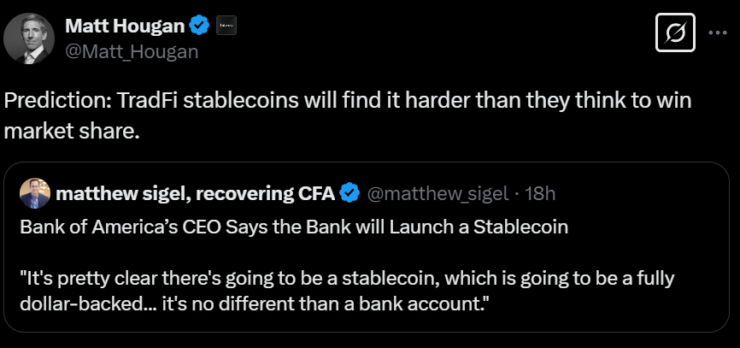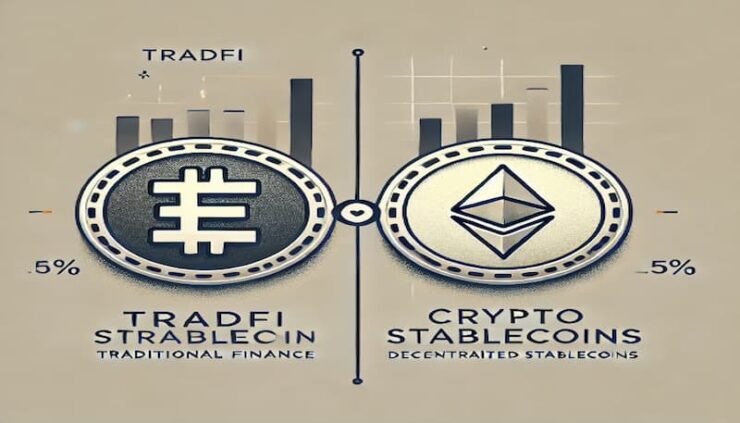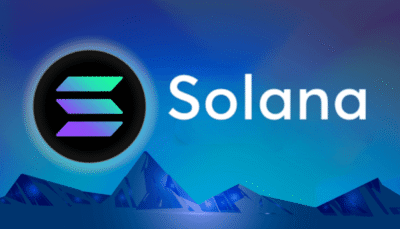Traditional finance (TradFi) institutions aiming to enter the stablecoin market may struggle to gain significant traction, according to Bitwise Chief Investment Officer Matt Hougan. In a Feb. 26 post on X, Hougan argued that bank-issued stablecoins will face major hurdles, including liquidity challenges, regulatory constraints, and user preference for decentralized alternatives.
“TradFi stablecoins will find it harder than they think to win market share,”
Hougan stated, referencing Bank of America (BofA) CEO Brian Moynihan’s recent comments about launching a US dollar-pegged stablecoin once regulators provide a clear framework.

The debate over TradFi stablecoins intensified after Circle co-founder Jeremy Allaire urged that all USD stablecoin issuers should be registered in the United States. This sparked discussions about whether bank-backed stablecoins are a step toward greater crypto adoption or simply a rebranded version of central bank digital currencies (CBDCs).
Stablecoins or Rebranded CBDCs?
Moynihan’s announcement triggered mixed reactions from the crypto community. While some welcomed the prospect of major banks integrating blockchain-based payment solutions, others saw it as an attempt to introduce CBDCs under a different name.
“So are they just going to rebrand CBDCs and call them stablecoins?” one user on X questioned, while another said the move “sounds CBDCish.”
Digital asset researcher Anderson, however, pointed out a fundamental distinction: “A CBDC is a direct liability of the central bank, while a stablecoin is a liability of the issuer. This has huge consequences.” This differentiation suggests that while bank-issued stablecoins may resemble CBDCs in function, they would still operate under different economic and regulatory frameworks.
The discussion aligns with the U.S. government’s growing interest in stablecoins. On Jan. 23, former U.S. President Donald Trump signed an executive order supporting the development of lawful and legitimate dollar-backed stablecoins worldwide while banning the introduction of a U.S. CBDC. This has led some to speculate that the government is actively steering toward private-sector-issued stablecoins instead of government-backed digital currencies.
The Looming Impact on Tether
As major financial institutions position themselves for stablecoin dominance, some analysts fear this could threaten Tether’s long-standing market leadership.
“So Tether will likely be outlawed or treated differently compared to other U.S. stablecoins. They are lobbying for this,” one X user speculated.
Tether CEO Paolo Ardoino expressed concern over recent legal and regulatory developments in the U.S., calling them “very troubling.” Responding to a post by Rumble CEO Chris Pavlovski, Ardoino appeared to suggest that new regulations could stifle competition in the stablecoin market.
“I’m getting a strong feeling that this toxic stablecoin legislation is negatively impacting Bitcoin price and hurting confidence in crypto,” Pavlovski wrote, implying that the legislation is designed to favor TradFi-backed stablecoins at the expense of independent issuers.
Despite the looming regulatory pressure, Ardoino remains confident in Tether’s market position. “Our focus has to be where we are needed the most,” he said, emphasizing that the highest demand for USDT comes from developing economies like Argentina, Turkey, and Vietnam rather than the U.S. and Europe.
The Future of TradFi Stablecoins
While bank-issued stablecoins may find institutional backing and regulatory approval, they will have to compete with established crypto-native options like USDT and USDC, which dominate liquidity pools and decentralized finance (DeFi) ecosystems. Additionally, concerns over centralized control and potential censorship in TradFi stablecoins may push users toward decentralized alternatives.
As the stablecoin sector evolves, the battle for dominance will likely be fought on multiple fronts—liquidity, accessibility, regulation, and user trust. Whether TradFi institutions can carve out a significant share of this rapidly growing market remains to be seen.





